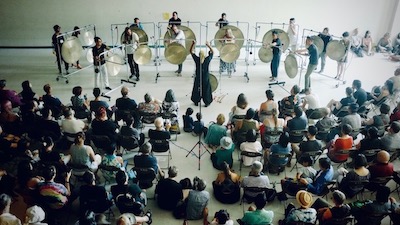by Jarrett Hoffman

There is only one ensemble in the world made up of gongs played with bows, and that’s the Nakatani Gong Orchestra, which will give a free performance at St. John’s Episcopal Church in Ohio City on Saturday, March 30 at 8:00 pm.
The group was founded by Tatsuya Nakatani, who describes the project on his website as nomadic. That’s because for each performance, he loads up his van with instrument stands, bows and gongs — now seventeen of them — and heads out on the road. Where are the players, you might ask?
No, they’re not ghosts, but Nakatani won’t meet them until he arrives in town for each performance. The local presenter rounds them up — the magic number is now fourteen. They tend to be from the music and art worlds, though they’re not expected to have any experience with gongs until taking part in a technique workshop and rehearsal with Nakatani.
He’ll begin the concert with an improvised solo set using a couple of gongs. “It’s very simple,” he told me over the phone from Knoxville, where he was playing as a solo percussionist in this year’s Big Ears Festival. “It’s just so people can see where the gong orchestra came from.” Then comes the main act: he’ll conduct the ensemble in a harmony-based composition of his, also improvised.
All of those different parts make it a challenging project, he said. “Every time it’s different, and I try to get the best out of the ensemble as much as possible.”
Why not have is own set group of players? “That would be the best-case scenario,” he said. “But this is not commercial music, classical music, or even conventional traditional music. It’s contemporary and in a way experimental sound art. I don’t think there’s money available for fourteen people to have hotel rooms, meals, and practice. I only started this ten years ago — maybe it takes more time.”
Speaking of that beginning, it all started from Nakatani’s fascination as a solo percussionist with bowing. That allows for a more constant sound, rather than one that quickly decays. “I had the idea of playing many long notes, which I cannot do by myself with two arms. But how about three, four people — how about ten?” he said.
With no conventional gong bows available, Nakatani has had to make them all by hand. He’s also fashioned a particular way to attach gongs to their stands, which makes the bowing produce “a very special sound,” he said.
After ten years of preparation and another nearly ten years of touring, how long does Nakatani see the project continuing?
“Good question!” he said, laughing. “I don’t know — maybe Erika can answer this.” He passed the phone to his wife, visual artist Erika Nakatani. She helps behind the scenes to facilitate the project, but lets others have the chance to play the instruments in performances.
“You’ve said before that you hope it lasts beyond your lifetime — that the development of this instrument continues to evolve,” she said.
“Yes,” he responded. His thoughts turned to traditional music. “For this to grow in that way takes generations of music. Ten years is very young for the gong orchestra.” And as with any instrument, both playing techniques and the instrument itself take time to fully mature. “Right now the gongs are unstable — they’re very difficult to play,” he said. He’s interested in making further tweaks, perhaps to the shape of the bow.
“If I die, maybe somebody will want to keep doing that, or maybe it will just finish. But at the moment it’s only me, so if we’re playing in Cleveland, it’s the only place in the world where a gong orchestra is performing.”
This will be his third time bringing the project to Northeast Ohio, after an early performance with only a few players at Oberlin and a second one at MOCA Cleveland. “I’m hoping that previous audiences will come back,” he said. “They can see some developments and changes, and also hear the different acoustics. Everything is completely different each time.”
Published on ClevelandClassical.com March 26, 2019.
Click here for a printable copy of this article




